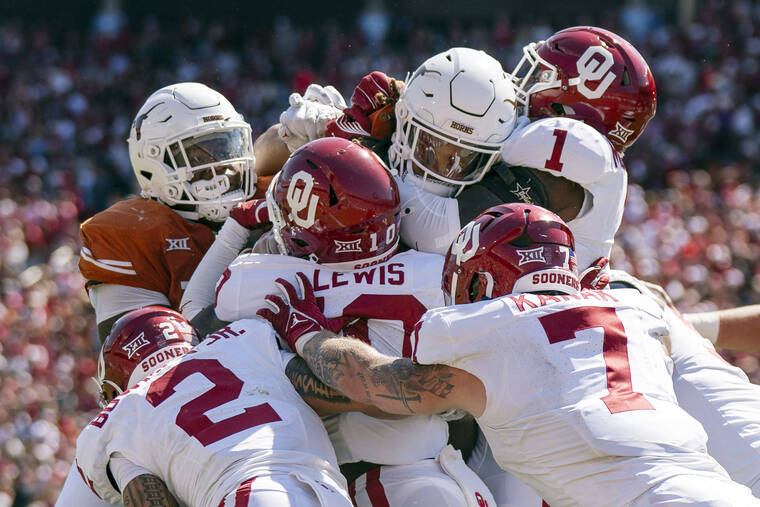
At a reception attended by several university presidents in Manhattan, Arizona State President Michael Crowe was asked to ponder a not-too-distant future where Sun Devils football and basketball players get a cut from the billions of dollars their sports generate in media rights deals.
“I don’t support that. And so are we preparing for it? The answer is no, we’re not,” Crowe recalled. “That is not an outcome which is conducive, in my view, to the success of the pluralistic, gender-balanced, college-sports framework that we presently have in the United States.”
All the same, the NCAA and major college sports conferences are facing yet another antitrust lawsuit — among other legal and political challenges — that could force decision-makers to reckon with a reality where some athletes are paid employees or at least get money in a revenue-sharing model that looks a lot like professional sports.
House vs. the NCAA is a class-action lawsuit being heard in the Northern District of California by Judge Claudia Wilken, whose previous rulings in NCAA cases paved the way for college athletes to profit from their fame and for schools to direct more money into their hands.
One of the rulings was appealed all the way to the Supreme Court, where justices ruled 9-0 against the NCAA in 2021. Justice Brett Kavanaugh’s blistering, concurring opinion from the Alston case still rings out.
“Nowhere else in America can businesses get away with agreeing not to pay their workers a fair market rate on the theory that their product is defined by not paying their workers a fair market rate,” Kavanaugh wrote.
Two years later, college sports is again in danger of having its future dictated by outside forces, unable or unwilling to get out in front of an issue.
NCAA President Charlie Baker is scheduled to testify to a Senate committee Tuesday, the 10th hearing on Capitol Hill focused on college sports since 2020.
The former Massachusetts governor and other college sports leaders continue to lobby for a federal law to regulate how athletes can be compensated for name, image and likeness work, but the next set of threats is closing in.
Two separate issues in front of the National Labor Relations Board — a complaint against USC and the Pac-12 and a unionization movement by Dartmouth’s men’s basketball team — along with another lawsuit in Pennsylvania could lead to college athletes being granted employee status. Hubbard vs. the NCAA is another antitrust case, seeking damages for some athletes who were denied education-related stipends that were the result of the Alston case.
But the California case is widely seen as the biggest threat to a longstanding amateur athlete model that isn’t changing quickly enough to satisfy its opponents.
“I’ve seen college athletics leaders say they want a sustainable and ‘legally defensible model.’ They then say Congress is the only place that can create that model. What they really mean is Congress is the only place that can allow for a model with the restrictions they want,” Kansas City-based sports attorney Mit Winter tweeted recently.
The California lawsuit, brought by Arizona State swimmer Grant House in 2020, could potentially cost the NCAA and major conferences more than $4 billion in damages, though Wilken has yet to decide whether a damages class should be certified.
A loss for the NCAA could require professional-sports style revenue sharing of those multibillion-dollar television deals for big-time college football and March Madness basketball because they involve the use of players’ names, images and likenesses.
“What we’re going to be asking the court to do for the class is to strike down all current prohibitions on NIL. And so the most significant is the rule that prohibits conferences from paying students for NIL,” said Steve Berman, one of the lead plaintiffs’ attorneys and a familiar legal foe of the NCAA.
Essentially, it would be time to pay the players.
“The writing has been on the wall for some time, with cases that come up specifically through the Ninth Circuit and we haven’t really seen a huge seismic shift on the NCAA’s part,” said Dan Lust, a professor at New York Law School. “The question is really, what happens to those other sports if they don’t have the same level of funding? That’s really the question.”
That’s a point the NCAA will make in its defense. As Crowe pointed out, even at the wealthiest Power Five programs such as Texas and Ohio State, the money brought in by football and basketball funds opportunities for hundreds of other athletes.
And if the biggest schools start paying their players, the pressure on the rest of Division I to try to compete would lead many to consolidate their resources to support fewer sports. There are legitimate questions about whether schools would be able to comply with Title IX.
“I want to find a way to fairly compensate our student-athletes for the value they bring to their universities while continuing to offer opportunities to all,” said Bryce Choate, a former distance runner at Oral Roberts and member of the NCAA Board of Governors.
College sports leaders have tried to walk a thin line with their requests for government involvement, at once asking for an NIL bill that pre-empts state laws and prevents athletes from being deemed employees of their schools while also wanting to avoid full-bore federal oversight.
The NCAA is no longer just waiting around for Congress to fix NIL, working on a set of rules — rules the House lawsuit aims to tear down whatever guardrails are put up. Berman said he expects a trial in the fall of 2024.
Crowe, the ASU president, said he would like to further enhance athletic scholarships, providing more money toward stipends and long-term health care coverage.
There are some in college sports who realize that won’t probably won’t be enough.
“The dollars that have flowed into our space are real,” Nebraska athletic director and former Huskers football star Trev Alberts told ESPN.com. “I’m not opposed to student-athletes participating in the sharing of ultimately what they’re helping to generate. … Change is hard, but … I’d rather get busy changing than slowly dying a death by 1,000 cuts.”
Read More: World News | Entertainment News | Celeb News
Star Ads





